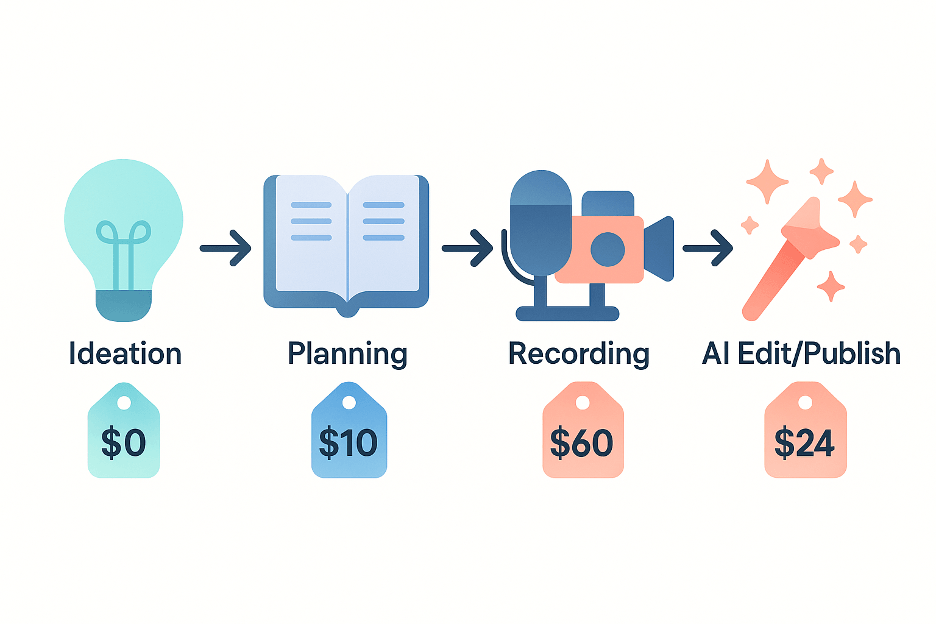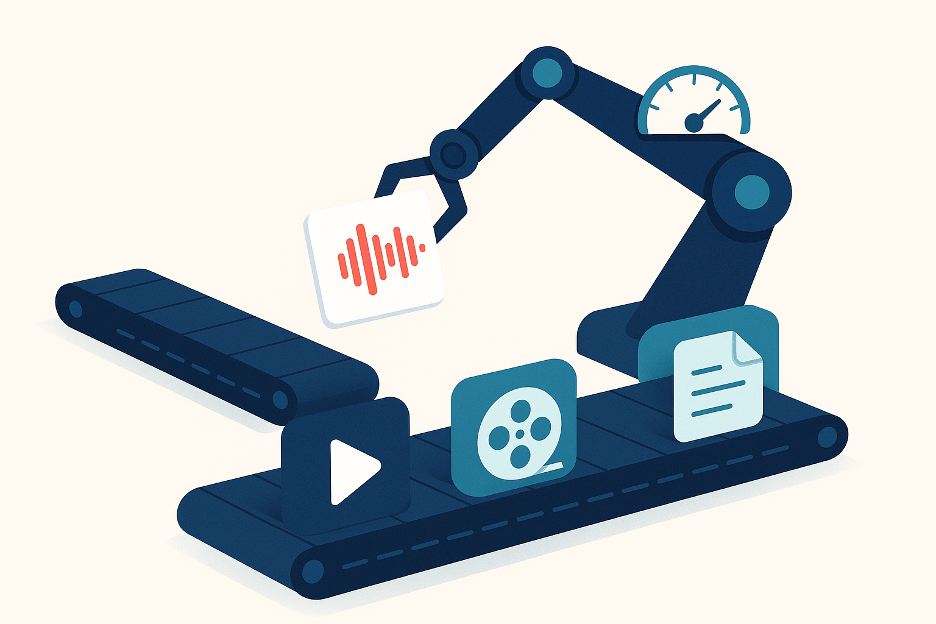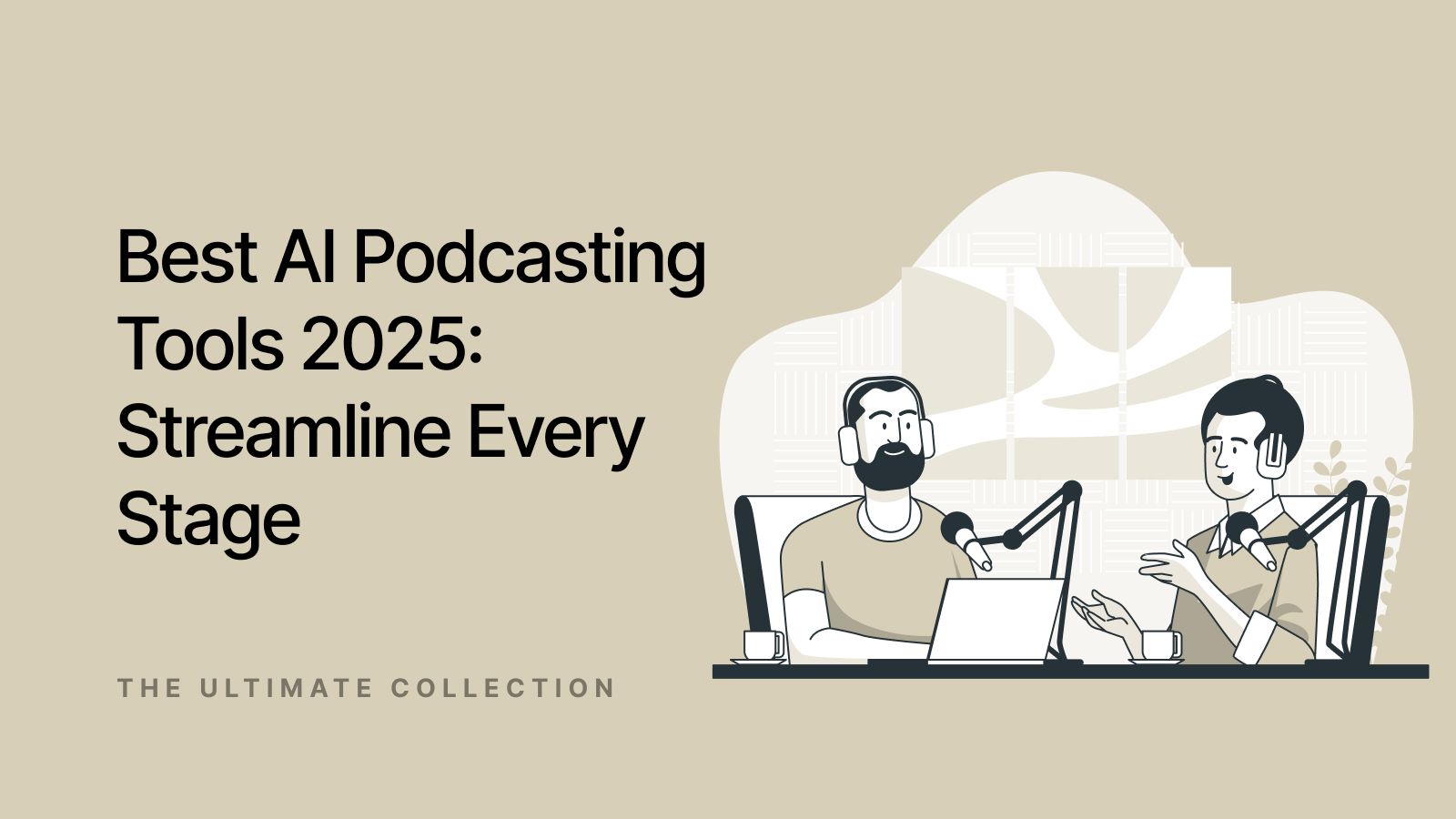Podcasting is no longer audio-only. In February 2025, TechCrunch reported that YouTube attracts more than 1 billion monthly podcast viewers—overtaking Spotify and Apple. The shift means you must juggle video, transcripts, and social clips, not just audio. This guide trims the fat: we map a lean toolkit for every stage, line up prices side by side, and highlight the newest AI shortcuts so you can publish faster.
Planning and ideation tools

Planning tools turn scattered thoughts into a clear episode roadmap—saving you from marathon edits later.
AI writing assistant (e.g., ChatGPT). OpenAI’s ChatGPT serves more than 400 million weekly users, according to Reuters (February 2025). Type “Five angles on remote-team burnout,” and it returns titles, segment ideas, and sample questions in seconds.Pros: instant idea generation, built-in thesaurus.Cons: outputs can feel generic—human curation still matters.Pricing: Free; ChatGPT Plus is $20 per month for faster GPT-4 access.
Digital notebooks (Notion, Evernote, Google Docs). Notion surpassed 30 million users in 2024, underscoring widespread adoption for collaborative outlining. Use a shared workspace to pin research, timestamps, and guest bios in one place.Pros: real-time collaboration, searchable database structure.Cons: learning curve for advanced templates; offline editing can be clunky.Pricing: Generous free tiers; team plans start around $8–10 per month per user.
Quick win: Add a simple content calendar inside your notebook. Slot tentative titles, mark guest confirmations, and reveal gaps before they derail your release cadence.
Invest ten minutes up front and many producers report shaving an hour or more off editing later (Cleanvoice workflow survey 2024). Thoughtful planning compounds into smoother production.
Local recording software
Local recorders save every syllable to your hard drive, so Wi-Fi hiccups never ruin a great take.
Audacity (free). The open-source veteran just turned 25, and its latest 3.7 build still records unlimited tracks on Windows, macOS, and Linux at no cost audacityteam.org. Pros: rock-solid, tiny download, huge plug-in community. Cons: dated interface, no real-time effects.
GarageBand (free for macOS/iOS). Mac users get a friendlier interface plus built-in music beds. It’s perfect for two-track interviews, but you’ll outgrow it if you need advanced routing.
Reaper ($60 one-time license, 60-day full trial). For the price of a decent XLR cable, you unlock pro-level routing, macros, and cue-sheet export from the Reaper website. Pros: lightning fast, runs on low-power laptops. Cons: steeper learning curve, spartan visuals.
Adobe Audition ($31–34 per month single-app subscription). Audition excels at spectral repair and batch processing, making it ideal for narrative podcasts rich in ambience, according to Capterra. Pros: world-class noise reduction, tight Creative Cloud integration. Cons: subscription cost adds up; resource-heavy on older machines.
A quality mic and a quiet room still matter, but pairing the right recorder with solid hardware locks in clean source material and can cut hours off post-production.
Remote recording and interview platforms
Remote recording platforms capture each guest locally, then sync tracks in the cloud, so spotty Wi-Fi never ruins your master file, and Revid.ai converts that pristine audio into a captioned video you can publish anywhere.
Riverside. Browser-based sessions record up to 4K video and 48 kHz audio, then generate AI “Magic Clips” for social posts. The Standard plan is $19 per month when billed monthly (or $15 per month annually), according to Riverside.
Pros: studio-level quality, auto-generated clips, free tier for short tests.
Cons: large video uploads can strain slow connections.
SquadCast. A backstage green room and automatic cloud backups ease first-timer nerves. The Creator plan costs $24 per user per month and includes 30 recording hours plus Dolby-powered mastering, per SquadCast’s pricing page.
Pros: intuitive interface, Dolby post-processing.
Cons: no perpetual free tier, per-seat pricing adds up for teams.
Zencastr. The free Hobbyist tier supports audio-only shows; paid plans start around $20 per user per month for WAV and HD video recording, according to Zencastr.
Pros: lowest barrier to entry, integrated hosting and transcripts.
Cons: interface feels busier, fewer AI edit tools.
Quick tip: Run a five-minute test call before each interview to confirm mics, levels, and local-file permissions, which prevents heartbreak from lost audio later.
Editing and post-production

Why polishing matters
Editing turns raw talk into a listener-ready story. Most podcasters spend 2–4 × the episode length fixing pauses, balancing levels, and adding music. A 60-minute chat can mean up to four hours in the timeline, notes Cleanvoice (2024). The right software narrows that gap without sacrificing craft.
Traditional audio editors
Audacity (free). Slice, cross-fade, and export on any OS. Pros: zero cost, vast plug-in library. Cons: dated interface, no real-time effects.
Reaper ($60 one-time after 60-day trial). Broadcast-grade routing and macros on a startup budget. Pros: lightning fast, plug-in agnostic. Cons: steep learning curve, minimalist visuals.
Adobe Audition ($31–34 per month single-app). Spectral repair and batch processing serve sound-rich narratives. Pros: industry-leading cleanup, Creative Cloud sync. Cons: subscription cost adds up, CPU heavy.
Traditional DAWs reward careful ears; if you love tweaking knobs, they remain the gold standard.
AI-powered editors and enhancers
Descript. Price: Free; Creator $12 per editor per month, Pro $24 per editor per month.Highlights: instant transcript, click-to-delete filler words, voice-clone overdubs.Watch-out: cloud reliant; transcripts need a proofread.
Alitu. Price: $38 per month after a seven-day trial.Highlights: auto-clean noise, level volumes, bolt-on intro or outro music; episode assembled in minutes.Watch-out: fewer granular controls than a full DAW.
Hindenburg PRO. Price: about $8–9 per month subscription or a one-time Journalist license (~$120).Highlights: smart-leveling locks voices to broadcast LUFS, clipboard for sound bites, chapter markers.Watch-out: spartan interface; less suited for music-heavy shows.
Auphonic. Price: Free two hours per month; nine-hour plan $11 per month.Highlights: loudness normalization, noise reduction, rumble cut, multiple output formats.Watch-out: not a full editor; quality depends on source audio.
Many producers find that pairing an AI editor with a traditional DAW and other content creation tools and adding an AI clip generator like Revid.ai, which automatically detects highlight moments and exports captioned, vertical shorts—cuts post-production time by 40–60 percent (Cleanvoice workflow survey 2024).”
Transcription and show-note automation
Search engines can’t listen, so every episode needs text. Podlab’s 2024 analysis found that publishing a clean transcript alongside the audio lifts organic traffic by 15 percent.
AI transcription first
Otter.ai converts a one-hour WAV in minutes and labels each speaker.Pricing: Basic plan free with 300 minutes per month and a 30-minute file cap. Pro is $8.33 per month (annual) for 1,200 minutes; Business is $20 per month for 6,000 minutes.Pros: fast, live meeting capture, generous free tier.Cons: accuracy dips in noisy tracks; long files require upgrade.
Human precision when it counts
Rev.com delivers 99 percent-accurate text for $1.99 per audio minute. AI transcripts cost $0.25 per minute. Great for legal or medical jargon.Pros: near-perfect spelling, optional timestamps.Cons: cost rises quickly on long shows.
Built-ins that multitask
Import audio into Descript and get 10 hours of transcription on the Creator plan at no extra cost. One click exports WebVTT captions for YouTube and most podcast players.
From transcript to show notes
After proofreading, pull three quotable moments, list resources, and craft a one-line teaser. Descript’s “AI Summary” and Rev’s auto-highlights shorten the draft process.
Record once, turn talk into text, and your back catalog keeps working long after the mics power down.
Conclusion
Podcasting has evolved into a multimedia craft—part talk show, part video production, and part SEO strategy. The tools and workflows that once supported simple audio files now stretch across AI-assisted writing, HD recording, video editing, and transcript automation. But sophistication doesn’t have to mean complexity.
By combining a few lean, well-chosen platforms—an AI writing partner like ChatGPT, a collaborative notebook such as Notion, a local or remote recorder (Reaper, Riverside), and an AI-assisted editor like Descript or Alitu—you can build a streamlined, repeatable pipeline that balances creativity with efficiency.
The smartest producers aren’t chasing every new app; they’re integrating a handful that work seamlessly together. The goal isn’t to automate away your voice—it’s to spend less time fighting software and more time crafting stories that connect. Whether your next episode lives on Spotify, YouTube, or both, a thoughtful, minimalist toolkit lets your message shine while keeping your production process lean and sustainable.
